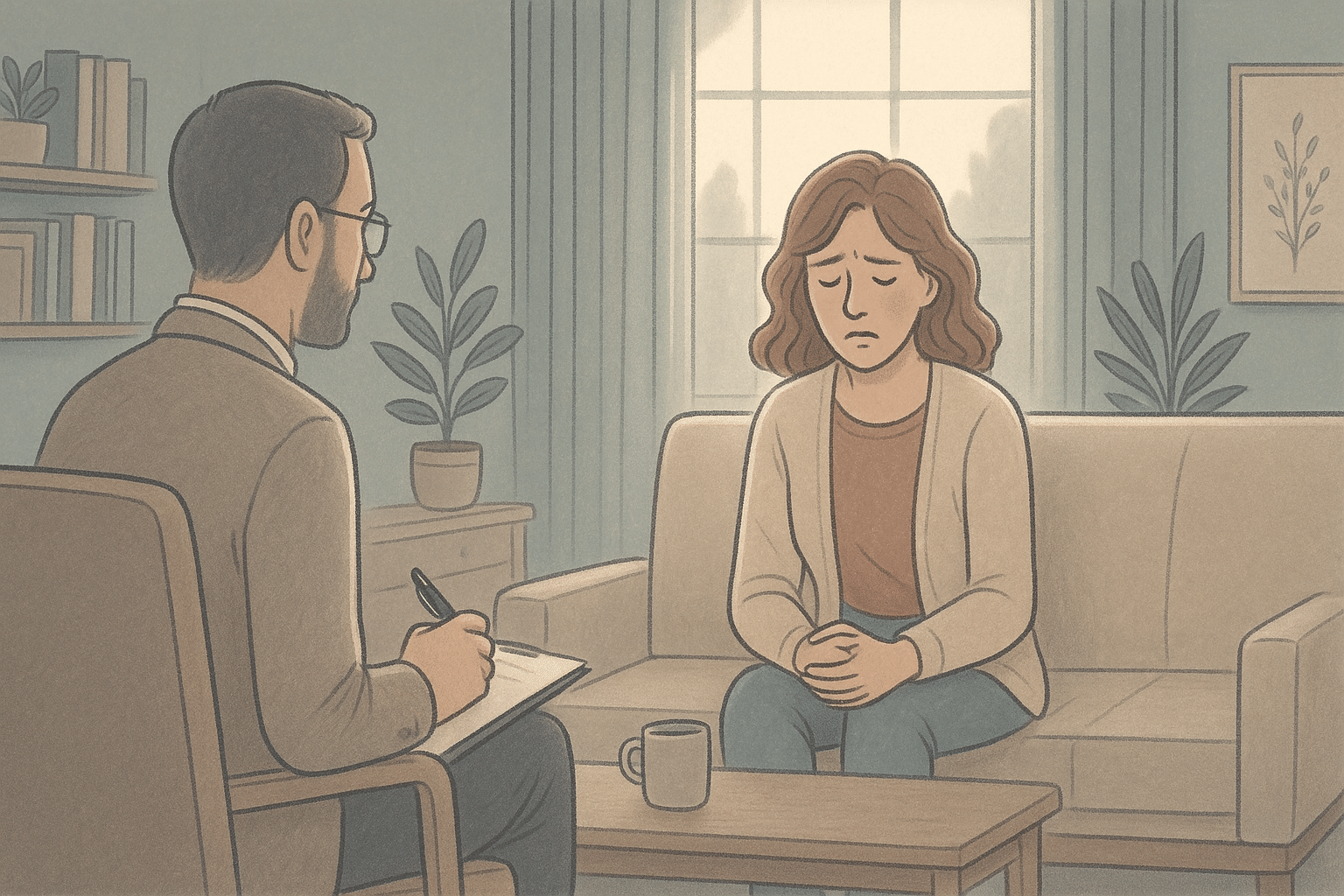Key Takeaways
- Knowing what panic attacks look like is important for getting help quickly.
- Breathing techniques and grounding methods can help to calm panic attacks.
- Regular exercise, stress management and a healthy diet can help to manage panic attacks in the long term.
- It’s important to seek professional help when panic attacks frequently disrupt daily life, with therapies like CBT being highly effective in altering harmful thought patterns and reducing future attacks.
- A Mission for Michael (AMFM) provides a comprehensive approach to panic attack management, emphasizing personalized care, expert therapies, and a supportive recovery environment to enhance overall mental wellness and life quality.
Recognizing Panic Attacks
Knowing when someone is having a panic attack is important for helping them. Research shows that people with panic disorder often notice things that others don’t, particularly things that make them feel afraid. This can make it more likely that neutral or ambiguous facial expressions will be misinterpreted as threatening, which could make anxiety symptoms worse.
| A Mission For Michael: Expert Mental Health Care Founded in 2010, A Mission For Michael (AMFM) offers specialized mental health care across Southern California, Minnesota, and Virginia. Our accredited facilities provide residential and outpatient programs, utilizing evidence-based therapies such as CBT, DBT, and EMDR. Our dedicated team of licensed professionals ensures every client receives the best care possible, supported by accreditations from The Joint Commission and the California Department of Health Care Services. We are committed to safety and personalized treatment plans. Start your recovery journey with AMFM today! |
Common Physical Symptoms:
- Rapid heartbeat or palpitations
- Sweating
- Trembling
- Shortness of breath
- Dizziness
- Nausea
Emotional Indicators
Panic attacks also present emotional and cognitive symptoms:
- Intense fear or anxiety
- Detachment from reality
- Fear of losing control or irrational behavior
- Fear of dying
Understanding Triggers
Knowing what makes you angry or stressed is important. A journal helps you find patterns and ways to avoid or calm down when you have an attack.
Immediate Coping Strategies
Controlled Breathing Techniques
Deep breathing is one of the most effective methods to manage a panic attack, as it counteracts the rapid, shallow breathing often associated with heightened anxiety.
A popular method is the 4-7-8 technique: inhale deeply through your nose for 4 seconds, hold your breath for 7 seconds, and exhale slowly through your mouth for 8 seconds. This technique calms the nervous system and helps with anxiety.
Grounding Methods
Grounding techniques help you stay calm in the moment. The 5-4-3-2-1 technique is a great method for identifying:
- 5 things you can see
- 4 things you can touch
- 3 things you can hear
- 2 things you can smell
- 1 thing you can taste
This structured approach helps shift your focus away from overwhelming emotions and back to your immediate surroundings. You can also try touching or holding a familiar object, such as a smooth stone or stress ball, or describe your surroundings out loud, focusing on vivid details like colors, textures, or shapes.
Using Mantras
Repeating a calming mantra is an effective way to redirect anxious thoughts and reduce panic. Short, reassuring phrases such as “This too shall pass,” “I am safe,” or “I am breathing in calmness, breathing out fear” can help ground your mind. Practicing these regularly can make them a natural response during an episode.
Progressive Muscle Relaxation
Relaxing your body can help relieve physical tension. Clench your fists, then say “relax.” This process releases tension and calms the body.
Movement and Exercise

Walking Benefits
Walking is an accessible and effective method to alleviate panic symptoms. It helps regulate breathing, boosts blood circulation, and provides a change of scenery, which can all contribute to easing the effects of a panic attack. You can walk anywhere, without needing special equipment or skills.
Light Exercises
Yoga and tai chi are good for your health. These activities help you focus on the present and reduce bodily tension. Short sessions can help you feel calm.
Endorphin Release
Physical activity releases endorphins, natural chemicals in the brain that act as painkillers and mood boosters. This helps to lower the impact of stress hormones like cortisol, which are often higher during panic attacks.
Environmental Adjustments
Finding Calm Spaces
It’s important to identify a calm space when experiencing a panic attack. It could be a room, park or imagined setting. Having a calm, safe place to go helps you relax.
Music and Sound Therapy
Music and nature sounds can dramatically reduce anxiety during a panic attack by shifting focus away from panic to the rhythm and melody, providing a mental escape. Preparing a playlist with calming tunes or ambient sounds such as ocean waves or rain creates a peaceful atmosphere, enhancing grounding and mindfulness.
| Type of Sound | Effect |
| Classical Music | Reduces stress and promotes relaxation |
| Nature Sounds | Helps with grounding and mindfulness |
| Guided Meditations | Offers structured relaxation techniques |
Visual Focus Techniques
Visual focus techniques involve concentrating on something to calm yourself. Looking at the details of things like colours, textures and patterns can help you relax.
Long-Term Management

Therapies and Counseling
Therapy, especially Cognitive Behavioral Therapy (CBT), is a great way to manage panic attacks. CBT helps you to spot and change the negative thought patterns that cause panic attacks. Working with a therapist can give you the tools and ongoing support you need to make progress.
Routine and Lifestyle Changes
Establishing a consistent routine can introduce stability and predictability, beneficial for those prone to panic attacks. Routine adjustments may include:
- Setting consistent sleep and wake times.
- Structuring meal plans.
- Allocating time for relaxation.
Minimizing caffeine, staying hydrated, and getting adequate sleep are crucial for maintaining mental health. These simple lifestyle modifications can significantly lessen anxiety and prevent panic attacks.
Mission for Michael for Panic Attack Management
At A Mission for Michael (AMFM), we offer a comprehensive and compassionate approach to managing panic attacks, aiming not just to alleviate symptoms but to address their underlying causes.
Expert Symptom Recognition and Early Intervention
We understand the intensity of panic attacks and provide expert care that helps individuals regain confidence and escape the cycle of overwhelming fear and isolation. At AMFM, we empower individuals to recognize and manage the early signs of panic attacks, such as a rapid heartbeat, sweating, shaking, and feelings of impending doom.
By teaching effective self-management techniques, we help prevent unnecessary emergency visits and ensure that appropriate and timely treatment is initiated.
Holistic and Empowering Approach
We emphasize long-term recovery and personal empowerment, enhancing resilience and coping skills through group therapy, peer support, and family counseling. Our commitment to clinical excellence is affirmed by accreditations from respected bodies like the Joint Commission and the California Department of Health Care Services.
A Path to Lasting Recovery
Choosing AMFM means opting for a treatment center that views recovery as a journey to reclaim life, emphasizing lasting well-being and freedom from the constraints of panic attacks.
Start your recovery journey with AMFM today.
Frequently Asked Questions (FAQ)
What are the most common symptoms of a panic attack?
Panic attacks typically manifest with symptoms such as a rapid heartbeat, sweating, trembling, shortness of breath, dizziness, and nausea. These are part of the body’s “fight or flight” response to perceived threats.
How can I immediately cope with a panic attack when it happens?
Breathe slowly and deeply, touch something familiar, and repeat a calming phrase like “This too shall pass” or “I am safe and in control.”
What long-term strategies are effective for managing panic attacks?
Long-term management includes regular exercise, stress management, a daily routine and possibly therapy.
When should I see a doctor for panic attacks?
In the event that an individual is experiencing frequent, severe panic attacks that are significantly impairing their quality of life, it is recommended that they seek the guidance of a qualified mental health professional.
Why I should select A Mission for Michael for my panic attacks
A Mission for Michael (AMFM) offers personalized care tailored to effectively manage and reduce your panic attacks. We specialize in comprehensive therapeutic interventions that focus on both immediate relief and long-term management strategies. Our expert team provides a supportive environment to help you regain control and improve your overall well-being.












